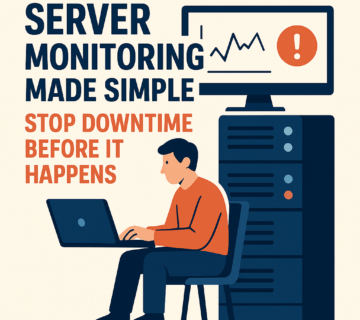Smart IT Consulting: How Orange County SMBs Can Cut Tech Costs Without Cutting Capability
🎙️ Dive Deeper with Our Podcast!
Orange County SMB IT Cost Optimization Strategy
Small and medium-sized businesses across Orange County face a persistent challenge: maintaining competitive technology capabilities while managing increasingly tight budgets. The pressure to innovate, secure data, and support remote workforces has never been higher, yet IT spending often feels like a runaway expense with diminishing returns.
The solution isn’t slashing budgets or eliminating critical systems—it’s working smarter through strategic IT consulting. Forward-thinking SMBs in Irvine, Newport Beach, and throughout Southern California are discovering that expert IT consulting services can actually reduce total technology spending while simultaneously improving performance, security, and scalability.
The Hidden Cost Crisis in SMB Technology
Many Orange County businesses operate under a dangerous misconception: that managing IT internally or through piecemeal vendors represents the most cost-effective approach. The reality reveals a different story.
Research consistently shows that businesses without strategic IT planning waste 20-30% of their technology budgets on redundant licenses, oversized infrastructure, poorly integrated systems, and reactive problem-solving. A manufacturing company in Anaheim might maintain three separate communication platforms when one integrated solution would serve better at half the cost. A professional services firm in Costa Mesa could be paying for software licenses that employees stopped using months ago.
These inefficiencies compound over time. Without regular IT cost optimization reviews, businesses accumulate technological debt—outdated systems requiring expensive maintenance, security gaps demanding emergency fixes, and integration challenges that slow productivity. The true expense isn’t just the direct costs but the opportunity cost of capital tied up in inefficient technology instead of growth initiatives.
The Strategic Advantage of IT Consulting Services
Professional IT consulting transforms technology from a cost center into a strategic asset. Rather than simply fixing problems as they arise, expert consultants analyze your entire technology ecosystem to identify optimization opportunities that internal teams typically miss.
The difference lies in perspective and expertise. Internal IT staff focuses on keeping systems running—an essential but reactive function. Strategic IT consultants bring cross-industry experience, vendor relationships, and architectural knowledge that reveals hidden inefficiencies and innovative solutions.
A retail business in Huntington Beach recently partnered with strategic IT consultants and discovered they were paying for enterprise-level software features that their operations never utilized. By right-sizing their licensing and negotiating better vendor terms, they reduced software costs by 42% while actually improving functionality through better-integrated alternatives. Their employees gained tools better suited to their workflows, and the finance team celebrated significant budget recovery.
License Optimization: The Low-Hanging Fruit
Software licensing represents one of the fastest routes to meaningful cost reduction. Most SMBs operate with licensing inefficiencies that silently drain budgets year after year.
Consider Microsoft 365, the backbone of many business operations. Organizations frequently purchase E5 licenses for every employee when E3 or Business Premium tiers would satisfy most users’ needs. The difference might seem small per user, but for a 50-person company, inappropriate licensing could mean $15,000-$20,000 in unnecessary annual spending.
License optimization extends beyond choosing the right tier. Expert Orange County IT consulting identifies unused licenses, seasonal staffing patterns that allow license reallocation, and opportunities to leverage existing agreements more effectively. Many businesses maintain licenses for departed employees, pay for redundant applications that overlap in functionality, or miss volume discount thresholds by just a few licenses.
The optimization process examines actual usage patterns rather than assumptions. Analytics reveal which applications employees truly use, which features justify premium licensing, and where consolidation opportunities exist. A healthcare services provider in Lake Forest reduced their software spending by $34,000 annually simply by aligning licenses with actual usage patterns and eliminating redundancies across departments.
Hybrid Infrastructure: Maximum Flexibility, Minimum Waste
The debate between on-premises infrastructure and cloud solutions creates a false choice. The most cost-effective approach for most Orange County SMBs involves strategic hybrid solutions that leverage the strengths of each environment.
Pure cloud strategies sound appealing but can generate unexpected costs as data transfer fees, storage expenses, and premium feature charges accumulate. Conversely, maintaining entirely on-premises infrastructure requires capital expenditure, ongoing maintenance, and often results in either over-provisioning or capacity limitations.
Hybrid architecture places workloads strategically based on cost efficiency, performance requirements, compliance needs, and access patterns. Customer databases requiring consistent high-speed access might remain on-premises, while backup systems and disaster recovery leverage affordable cloud storage. Development environments can spin up in the cloud for project duration, then shut down to eliminate idle costs.
A legal firm in Santa Ana implemented a hybrid strategy that moved their document management system to the cloud while keeping their case management database on optimized local servers. The result delivered 35% infrastructure cost reduction, improved disaster recovery capabilities, and eliminated the performance issues they experienced with their previous all-cloud attempt.
Proactive Planning Versus Reactive Spending
Perhaps the most significant cost difference between strategic IT consulting and traditional management lies in the shift from reactive firefighting to proactive planning.
Reactive IT management operates in crisis mode. A server fails, and suddenly you’re purchasing emergency replacement hardware at premium prices. Security vulnerabilities emerge, requiring expensive emergency remediation. Systems become incompatible, necessitating urgent integration projects. Each crisis consumes budget dollars and generates productivity losses that dwarf the direct repair costs.
Proactive IT strategy anticipates challenges before they become emergencies. Regular assessments identify aging equipment before failure, security audits catch vulnerabilities before breaches occur, and capacity planning prevents performance bottlenecks. This forward-looking approach eliminates emergency premiums, allows for competitive vendor negotiation, and schedules changes during optimal business windows.
The financial impact extends beyond avoiding crisis spending. Proactive planning enables accurate budgeting, eliminates surprise expenses that disrupt financial planning, and creates opportunities for strategic investments rather than emergency patches. A construction management firm in Mission Viejo discovered that implementing proactive IT planning reduced their annual emergency IT spending by 67%, freeing up capital for strategic initiatives that actually improved competitive positioning.
Vendor Management and Negotiation Leverage
Most SMBs lack the purchasing power and vendor relationships that enterprise organizations command. Strategic IT consulting services bridge this gap through aggregated buying power and established vendor partnerships.
Experienced IT consultants maintain relationships with technology vendors, understand pricing structures, know which terms are negotiable, and recognize when vendors offer poor value. This knowledge translates directly to cost savings on everything from software licenses to hardware procurement to service agreements.
Beyond pure price negotiation, effective vendor management ensures you’re not locked into unfavorable terms, identifies alternatives when vendors underperform, and leverages competitive pressure to improve service quality. A manufacturing company in Fullerton reduced their telecommunications costs by 28% when their IT consultant identified a better-fit provider and negotiated favorable contract terms that their previous vendor had claimed were impossible.
Security Investment: Optimization, Not Elimination
Cost reduction never means compromising security—especially in today’s threat environment where cyberattacks increasingly target SMBs. Strategic IT consulting optimizes security spending to maximize protection while eliminating redundant or ineffective investments.
Many businesses implement security measures in piecemeal fashion, resulting in overlapping tools, coverage gaps, and inflated costs. They might maintain three different antivirus solutions, two backup systems, and multiple monitoring platforms—creating complexity rather than protection.
Comprehensive security architecture consolidates protections into integrated layers that deliver better coverage at lower total cost. Modern security platforms combine endpoint protection, email security, identity management, and threat detection in unified solutions that cost less than maintaining separate point products.
An accounting firm in Brea reduced security spending by 31% while actually improving their security posture by consolidating six separate security tools into two comprehensive platforms. The integration improved threat visibility, simplified management, and eliminated the gaps between disconnected systems.
The ROI of IT Consulting Services
The return on investment for strategic IT consulting typically becomes apparent within the first quarter. Initial assessments commonly identify immediate cost savings that exceed annual consulting fees, while long-term benefits compound through improved efficiency, reduced downtime, and strategic technology leverage.
Consider the comprehensive ROI picture beyond direct cost savings. Optimized IT infrastructure improves employee productivity by reducing system slowdowns and eliminating workarounds. Better security prevents the catastrophic costs of data breaches. Improved reliability maintains business continuity. Strategic technology investments support growth rather than merely maintaining operations.
A professional services firm in Newport Beach calculated that their IT consulting partnership generated 412% ROI in the first year through direct cost reductions, avoided emergency expenses, and productivity improvements from better-performing systems. The strategic roadmap developed through the consulting relationship positioned them to scale operations without proportional IT cost increases.
Real-World Cost Optimization Results
Orange County businesses implementing strategic IT cost optimization consistently achieve significant results. A medical device distributor in Irvine reduced total IT spending by $127,000 annually through license optimization, hybrid infrastructure redesign, and proactive maintenance planning. Their systems became more reliable, security improved, and the IT budget transformed from an uncontrollable expense to a manageable investment.
A wholesale distribution company in Costa Mesa cut software licensing costs by 38% while adding capabilities through better vendor selection and right-sized solutions. They eliminated five redundant applications, consolidated data systems, and improved integration between platforms—all while spending less.
These aren’t isolated success stories. Businesses across Orange County are discovering that expert IT cost optimization delivers measurable financial impact while improving technology effectiveness.
Key Areas Where IT Consulting Drives Cost Reduction
Strategic IT consulting identifies optimization opportunities across multiple dimensions of technology spending:
Software and Licensing: Right-sizing licenses to actual usage, eliminating redundant applications, negotiating better terms, leveraging volume discounts, and identifying lower-cost alternatives that deliver equal or better functionality.
Infrastructure and Hosting: Optimizing server capacity, implementing hybrid architectures, eliminating over-provisioned resources, leveraging cloud economics strategically, and timing hardware refreshes for maximum value.
Support and Maintenance: Shifting from reactive break-fix to proactive management, preventing expensive emergencies, optimizing service agreements, and eliminating vendor overlap.
Telecommunications: Consolidating providers, negotiating better rates, right-sizing bandwidth and services, and identifying modern alternatives to legacy systems.
Security and Compliance: Consolidating security tools, eliminating redundancy, implementing cost-effective comprehensive protections, and avoiding the massive costs of breaches and compliance failures.
Each area offers significant optimization potential, and comprehensive IT consulting addresses all dimensions simultaneously rather than optimizing in silos that miss integration opportunities.
Building Your IT Cost Optimization Roadmap
Effective cost optimization follows a structured approach that ensures sustainable improvements rather than short-term cuts that create long-term problems. The process begins with comprehensive assessment—documenting all technology assets, licenses, services, and costs to establish baseline spending and identify immediate opportunities.
Analysis follows assessment, examining usage patterns, performance metrics, security posture, and business alignment. This phase reveals where technology investments deliver value and where spending generates minimal return.
Strategy development creates a prioritized roadmap that sequences optimizations for maximum impact while managing change effectively. Quick wins that deliver immediate cost savings without operational disruption come first, building momentum and generating funds for longer-term strategic initiatives.
Implementation executes the roadmap with careful change management, testing, and validation. This phase includes vendor negotiations, system migrations, license adjustments, and architectural changes—all managed to minimize business disruption.
Ongoing optimization maintains gains and identifies new opportunities as business needs evolve, technology advances, and vendor offerings change. Cost optimization isn’t a one-time project but a continuous discipline that sustains financial and operational benefits.
Frequently Asked Questions
How quickly can IT consulting services reduce technology costs?
Most businesses see immediate cost reductions within 30-60 days of engaging strategic IT consulting services. Initial assessments typically identify quick wins like eliminating unused licenses, renegotiating vendor contracts, or consolidating redundant services. These fast returns often cover consulting costs within the first quarter. Longer-term savings from infrastructure optimization, architectural improvements, and strategic planning compound over time, delivering even greater ROI in subsequent years.
Will cost optimization impact system performance or reliability?
Strategic IT cost optimization improves rather than compromises performance and reliability. The goal is eliminating waste and inefficiency, not cutting necessary capabilities. By right-sizing resources, consolidating systems, and implementing proactive management, businesses often experience better performance at lower cost. Optimization removes complexity, reduces points of failure, and focuses spending on technologies that truly support business objectives.
How is IT consulting different from hiring internal IT staff?
Internal IT staff focus on daily operations, keeping systems running, and resolving immediate issues—critical functions for any business. IT consulting services complement internal teams by bringing strategic expertise, cross-industry experience, vendor relationships, and architectural knowledge that most SMBs cannot justify maintaining in-house. Consultants provide objective analysis without organizational politics, stay current on emerging technologies and best practices, and deliver specialized expertise for specific challenges. The combination of capable internal staff and strategic consulting guidance produces better outcomes than either approach alone.
What size business benefits most from IT cost optimization?
Businesses with 10-500 employees typically gain the most significant benefits from strategic IT cost optimization. Organizations in this range have complex enough technology environments to accumulate inefficiencies but lack the dedicated resources and purchasing power of enterprise companies. However, even smaller businesses with focused technology needs can benefit from expert license optimization and vendor management, while larger organizations find value in specialized consulting for specific challenges or divisions.
How do you measure the success of IT cost optimization?
Success metrics include direct cost reduction measured against baseline spending, avoided costs from prevented emergencies and downtime, productivity improvements from better-performing systems, risk reduction through improved security and compliance, and strategic capability gained through better technology investments. Comprehensive measurement examines total cost of ownership rather than simple purchase prices, capturing the full financial impact including operational expenses, support costs, productivity factors, and business risk.
Can businesses maintain cost savings over time or do expenses creep back up?
Sustained cost management requires ongoing attention rather than one-time fixes. Strategic IT consulting establishes processes, governance, and regular reviews that maintain optimization gains over time. Businesses that implement recommended practices—regular license audits, proactive capacity planning, vendor relationship management, and strategic roadmap updates—sustain and often improve upon initial savings. Those treating optimization as a one-time project without establishing ongoing disciplines typically see costs gradually increase as inefficiencies accumulate again.
What if we’ve already tried to optimize costs internally without much success?
Internal optimization efforts often struggle because teams lack objective perspective on their own environments, miss cross-functional optimization opportunities, lack vendor negotiation leverage, and focus necessarily on operational demands rather than strategic analysis. External IT consulting brings fresh perspective, broader experience, vendor relationships, and dedicated focus on optimization that internal teams cannot typically provide. Many businesses that struggled with internal cost management achieve significant results once they engage expert consultants who can identify and address blind spots.
How does IT cost optimization align with business growth plans?
Strategic IT consulting ensures technology investments support growth rather than consuming capital that could fund expansion. By eliminating wasteful spending and optimizing existing technology, businesses free up budget for strategic initiatives that drive revenue and competitive advantage. Effective optimization creates scalable architectures that accommodate growth without proportional cost increases, allowing technology spending to scale more efficiently than business growth. This alignment transforms IT from a growth constraint into a growth enabler.
How Technijian Can Help
Technijian brings over two decades of IT consulting expertise to Orange County businesses seeking to optimize technology costs without sacrificing capabilities. Our approach combines comprehensive assessment, strategic planning, and hands-on implementation to deliver measurable cost reductions while improving performance, security, and scalability.
Our IT cost optimization services include complete technology audits that document all assets, licenses, services, and spending patterns to establish accurate baselines and identify immediate opportunities. We analyze usage patterns, performance metrics, and business alignment to distinguish between valuable investments and wasteful spending.
We specialize in software license optimization across Microsoft 365, business applications, and specialized tools. Our vendor relationships and negotiation expertise consistently secure better pricing, terms, and service levels than businesses achieve independently. We understand licensing structures, know which terms are negotiable, and leverage competitive pressure to maximize value.
Our infrastructure consulting designs hybrid architectures that strategically place workloads based on cost efficiency, performance requirements, and business needs. We eliminate over-provisioned resources, right-size capacity, and implement technologies that deliver better results at lower total cost of ownership.
Technijian implements proactive IT management that prevents expensive emergencies through regular maintenance, security monitoring, and capacity planning. This forward-looking approach eliminates crisis spending, enables accurate budgeting, and focuses resources on strategic initiatives rather than reactive firefighting.
Our security optimization consolidates protections into comprehensive, integrated platforms that deliver better coverage at lower cost than disconnected point solutions. We implement modern security architectures that scale with business growth while maintaining budget predictability.
We serve businesses throughout Orange County, including Irvine, Newport Beach, Costa Mesa, Santa Ana, Anaheim, Huntington Beach, and surrounding Southern California communities. Our local presence enables responsive service, face-to-face consultations, and deep understanding of the regional business environment.
Our IT consulting services deliver rapid ROI through identified cost savings, improved operational efficiency, reduced downtime, enhanced security, and strategic technology roadmaps that align IT investments with business objectives. Most clients achieve cost reductions exceeding consulting fees within the first quarter, with benefits compounding over time.
Whether you’re struggling with unpredictable IT expenses, seeking to optimize existing technology investments, planning for growth, or simply want to ensure your technology spending delivers maximum value, Technijian provides the expertise, experience, and strategic guidance to transform IT from a cost burden into a competitive advantage.
Ready to discover how much your business could save through strategic IT cost optimization? Contact Technijian today to schedule your free IT cost assessment. Our experts will analyze your current technology spending, identify immediate optimization opportunities, and develop a customized roadmap for reducing costs while improving capabilities. Let us show you how smart IT consulting can cut your technology expenses without cutting corners on the performance, security, and reliability your business demands.





